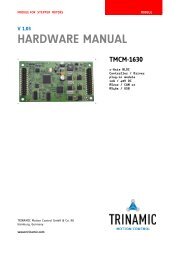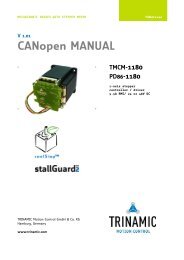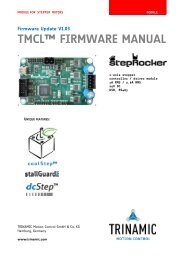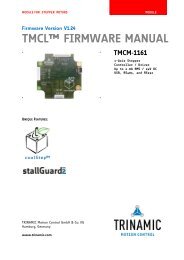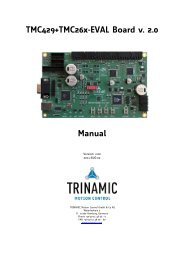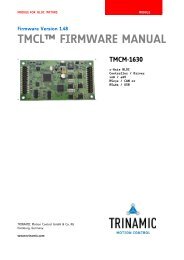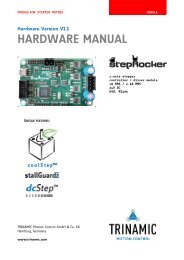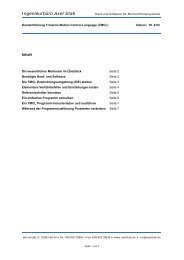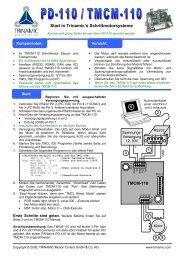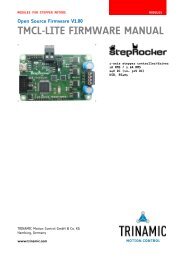PD86-1180 Hardware Manual (.pdf) - Trinamic
PD86-1180 Hardware Manual (.pdf) - Trinamic
PD86-1180 Hardware Manual (.pdf) - Trinamic
Create successful ePaper yourself
Turn your PDF publications into a flip-book with our unique Google optimized e-Paper software.
MECHATRONIC DRIVES WITH STEPPER MOTOR PANdrives<br />
V 1.01<br />
HARDWARE MANUAL<br />
+ + TMCM-<strong>1180</strong><br />
<strong>PD86</strong>-<strong>1180</strong><br />
+ +<br />
TRINAMIC Motion Control GmbH & Co. KG<br />
Hamburg, Germany<br />
www.trinamic.com<br />
1-axis stepper<br />
controller / driver<br />
5.5A RMS/ 24 or 48V DC<br />
USB, RS232, RS485, and CAN
TMCM-<strong>1180</strong> and <strong>PD86</strong>-<strong>1180</strong> <strong>Hardware</strong> <strong>Manual</strong> (V1.01 / 2011-MAR-21) 2<br />
Table of contents<br />
1 Life support policy ....................................................................................................................................................... 3<br />
2 Features ........................................................................................................................................................................... 4<br />
3 Order codes .................................................................................................................................................................... 5<br />
4 Mechanical and electrical interfacing ..................................................................................................................... 6<br />
4.1 TMCM-<strong>1180</strong> dimensions and mounting holes ............................................................................................. 6<br />
4.2 <strong>PD86</strong>-<strong>1180</strong> dimensions and motor specifications ...................................................................................... 7<br />
4.2.1 Dimensions of <strong>PD86</strong>-3-<strong>1180</strong> ........................................................................................................................ 7<br />
4.2.2 Motor specifications of QSH8618-96-55-700 ........................................................................................... 8<br />
4.2.3 Torque figure of QSH8618-96-55-700 ........................................................................................................ 9<br />
4.3 Connectors of TMCM-<strong>1180</strong> ............................................................................................................................... 10<br />
4.3.1 Power connector .......................................................................................................................................... 11<br />
4.3.2 Serial communication connector ............................................................................................................ 12<br />
4.3.3 USB connector .............................................................................................................................................. 12<br />
4.3.4 Output connector ......................................................................................................................................... 13<br />
4.3.5 Input connector ........................................................................................................................................... 14<br />
4.3.6 Step/Direction connector ........................................................................................................................... 16<br />
4.3.7 Encoder connector....................................................................................................................................... 17<br />
4.3.8 Motor connector and specifications ....................................................................................................... 18<br />
5 Jumpers ......................................................................................................................................................................... 19<br />
5.1 RS485 bus termination ..................................................................................................................................... 19<br />
5.2 CAN bus termination ........................................................................................................................................ 19<br />
6 Operational ratings .................................................................................................................................................... 20<br />
7 Functional description .............................................................................................................................................. 21<br />
7.1 System architecture ........................................................................................................................................... 21<br />
7.1.1 Microcontroller ............................................................................................................................................. 21<br />
7.1.2 EEPROM ........................................................................................................................................................... 22<br />
7.1.3 TMC428 motion controller ......................................................................................................................... 22<br />
7.1.4 Stepper motor driver .................................................................................................................................. 22<br />
7.1.5 sensOstep encoder .................................................................................................................................. 23<br />
8 TMCM-<strong>1180</strong> operational description ...................................................................................................................... 24<br />
8.1 Calculation: Velocity and acceleration vs. microstep and fullstep frequency .................................. 24<br />
9 TMCL ........................................................................................................................................................................... 26<br />
10 CANopen ....................................................................................................................................................................... 27<br />
11 Revision history .......................................................................................................................................................... 28<br />
11.1 Document revision ............................................................................................................................................ 28<br />
11.2 <strong>Hardware</strong> revision ............................................................................................................................................. 28<br />
12 References..................................................................................................................................................................... 29<br />
Copyright © 2011, TRINAMIC Motion Control GmbH & Co. KG
TMCM-<strong>1180</strong> and <strong>PD86</strong>-<strong>1180</strong> <strong>Hardware</strong> <strong>Manual</strong> (V1.01 / 2011-MAR-21) 3<br />
1 Life support policy<br />
TRINAMIC Motion Control GmbH & Co. KG does not<br />
authorize or warrant any of its products for use in life<br />
support systems, without the specific written consent of<br />
TRINAMIC Motion Control GmbH & Co. KG.<br />
Life support systems are equipment intended to support or<br />
sustain life, and whose failure to perform, when properly<br />
used in accordance with instructions provided, can be<br />
reasonably expected to result in personal injury or death.<br />
© TRINAMIC Motion Control GmbH & Co. KG 2011<br />
Information given in this data sheet is believed to be<br />
accurate and reliable. However neither responsibility is<br />
assumed for the consequences of its use nor for any<br />
infringement of patents or other rights of third parties,<br />
which may result from its use.<br />
Specifications are subject to change without notice.<br />
Copyright © 2011, TRINAMIC Motion Control GmbH & Co. KG
TMCM-<strong>1180</strong> and <strong>PD86</strong>-<strong>1180</strong> <strong>Hardware</strong> <strong>Manual</strong> (V1.01 / 2011-MAR-21) 4<br />
2 Features<br />
The <strong>PD86</strong>-<strong>1180</strong> is a full mechatronic device consisting of a NEMA 34 (flange size 86mm) stepper motor,<br />
controller/driver electronics and integrated encoder.<br />
Applications<br />
Powerful single-axis stepper motor solutions<br />
Encoder feedback for high reliability operation<br />
Electrical data<br />
Supply voltage: +24V DC or +48V DC nominal<br />
Motor current: up to 5.5A RMS (programmable)<br />
PANdrive motor<br />
Two phase bipolar stepper motor with up to 5.5A RMS nom. coil current<br />
Holding torque: 7Nm<br />
Integrated encoder<br />
Integrated sensOstep magnetic encoder (max. 256 increments per rotation) e.g. for step-loss<br />
detection under all operating conditions and positioning<br />
Integrated motion controller<br />
Motion profile calculation in real-time (TMC428 motion controller)<br />
On the fly alteration of motor parameters (e.g. position, velocity, acceleration)<br />
High performance ARM7 microcontroller for overall system control and serial communication<br />
protocol handling<br />
Integrated bipolar stepper motor driver<br />
Up to 256 microsteps per full step<br />
High-efficient operation, low power dissipation (MOSFETs with low R DS(ON))<br />
Dynamic current control<br />
Integrated protection<br />
Automatic load dependent motor current adaptation for reduced power consumption and heat<br />
dissipation (coolStep)<br />
Interfaces<br />
inputs for stop switches (left and right) and home switch<br />
general purpose inputs and 2 general purpose outputs<br />
USB, RS232, RS485 and CAN (2.0B up to 1Mbit/s) communication interfaces<br />
Safety features<br />
Shutdown input. The driver will be disabled in hardware as long as this pin is left open or shorted<br />
to ground<br />
Separate supply voltage inputs for driver and digital logic – driver supply voltage may be switched<br />
off externally while supply for digital logic and therefore digital logic remains active<br />
Software<br />
TMCL: stand-alone operation or remote controlled operation<br />
TMCL: program memory (non volatile) for up to 2048 TMCL commands<br />
TMCL: PC-based application development software TMCL-IDE available for free<br />
CANopen (under development): CiA 301 + CiA 402 (homing mode, profile position mode and velocity<br />
mode) supported<br />
Please see separate TMCL and CANopen Firmware <strong>Manual</strong>s for additional information<br />
Copyright © 2011, TRINAMIC Motion Control GmbH & Co. KG
TMCM-<strong>1180</strong> and <strong>PD86</strong>-<strong>1180</strong> <strong>Hardware</strong> <strong>Manual</strong> (V1.01 / 2011-MAR-21) 5<br />
3 Order codes<br />
Order code Description Dimensions<br />
TMCM-<strong>1180</strong>-TMCL TMCM-<strong>1180</strong> with coolStep, sensOstep, and 85.9 x 85.9 x 21.5<br />
TMCL Firmware<br />
TMCM-<strong>1180</strong>-CANopen TMCM-<strong>1180</strong> with coolStep, sensOstep, and 85.9 x 85.9 x 21.5<br />
CANopen Firmware (under development)<br />
<strong>PD86</strong>-3-<strong>1180</strong>-TMCL <strong>PD86</strong>-3-<strong>1180</strong> with coolStep, sensOstep, and 85.9 x 85.9 x 118.5<br />
TMCL Firmware, 7.0 Nm<br />
<strong>PD86</strong>-3-<strong>1180</strong>-CANopen <strong>PD86</strong>-3-<strong>1180</strong> with coolStep, sensOstep, and 85.9 x 85.9 x 118.5<br />
CANopen Firmware, 7.0 Nm<br />
TMCM-<strong>1180</strong>-Cable<br />
Related Motor:<br />
Cable loom for TMCM-<strong>1180</strong><br />
QSH8618-96-55-700 QMot stepper motor 86mm, 5.5A, 7.0Nm 85.85 x 85.85 x 96.0<br />
Table 3.1: Order codes<br />
Copyright © 2011, TRINAMIC Motion Control GmbH & Co. KG
TMCM-<strong>1180</strong> and <strong>PD86</strong>-<strong>1180</strong> <strong>Hardware</strong> <strong>Manual</strong> (V1.01 / 2011-MAR-21) 6<br />
4 Mechanical and electrical interfacing<br />
4.1 TMCM-<strong>1180</strong> dimensions and mounting holes<br />
The dimensions of the controller/driver board (TMCM-<strong>1180</strong>) are approx. 86mm x 86mm in order to fit to the<br />
back side of the 86mm stepper motor. The TMCM-<strong>1180</strong> is 21.5mm high without matching connectors. There<br />
are four mounting holes for M4 screws.<br />
72<br />
67.45<br />
8<br />
2<br />
13.9<br />
8<br />
2<br />
4.55<br />
13.9<br />
18.45<br />
R5.9<br />
67.45<br />
85.9<br />
TMCM-<strong>1180</strong><br />
Copyright © 2011, TRINAMIC Motion Control GmbH & Co. KG<br />
72<br />
81.35<br />
Figure 4.1: Dimensions of TMCM-<strong>1180</strong> and mounting holes<br />
M4<br />
4.55<br />
18.45<br />
81.35<br />
85.9
TMCM-<strong>1180</strong> and <strong>PD86</strong>-<strong>1180</strong> <strong>Hardware</strong> <strong>Manual</strong> (V1.01 / 2011-MAR-21) 7<br />
4.2 <strong>PD86</strong>-<strong>1180</strong> dimensions and motor specifications<br />
The <strong>PD86</strong>-<strong>1180</strong> includes the TMCM-<strong>1180</strong> stepper motor controller/driver electronic module, a magnetic<br />
encoder based on sensOstep technology and an 86mm flange size bipolar hybrid stepper motor.<br />
4.2.1 Dimensions of <strong>PD86</strong>-3-<strong>1180</strong><br />
73.02±0.05<br />
1.1<br />
11.6<br />
25<br />
31.75±1<br />
12.7<br />
1.52<br />
73.02±0.05<br />
8.38<br />
4 x ø 5.5<br />
Copyright © 2011, TRINAMIC Motion Control GmbH & Co. KG<br />
96<br />
69.5±0.2<br />
85.9<br />
12.7<br />
400 min.<br />
11.6<br />
85.85<br />
Figure 4.2: <strong>PD86</strong>-3-<strong>1180</strong> dimensions<br />
4.1<br />
22.5 max<br />
1.4<br />
17<br />
85.9<br />
69.5±0.2
TMCM-<strong>1180</strong> and <strong>PD86</strong>-<strong>1180</strong> <strong>Hardware</strong> <strong>Manual</strong> (V1.01 / 2011-MAR-21) 8<br />
4.2.2 Motor specifications of QSH8618-96-55-700<br />
Specifications<br />
Wiring<br />
Units QSH8618-96-55-700<br />
Rated Voltage V 2.56<br />
Rated Phase Current (nominal) A 5.5<br />
Phase Resistance at 20°C Ω 0.45<br />
Phase Inductance (typ.) mH 4.5<br />
Holding Torque (typ.) Nm 7.0<br />
Detent Torque Nm<br />
Rotor Inertia gcm2 2700<br />
Weight (Mass) Kg 2.8<br />
Insulation Class B<br />
Insulation Resistance Ω 100M<br />
Dialectic Strength (for one<br />
minute)<br />
VAC 500<br />
Connection Wires N° 4<br />
Max applicable Voltage V 140<br />
Step Angle ° 1.8<br />
Step angle Accuracy % 5<br />
Flange Size (max.) mm 85.85<br />
Motor Length (max.) mm 96<br />
Axis Diameter mm 12.7<br />
Axis Length (visible part, typ.) mm 31.75<br />
Axis D-cut (1.1mm depth) mm 25.0<br />
Shaft Radial Play (450g load) mm 0.02<br />
Shaft Axial Play (450g load) mm 0.08<br />
Maximum Radial Force<br />
(20 mm from front flange)<br />
N 220<br />
Maximum Axial Force N 60<br />
Ambient Temperature °C -20… +50<br />
Temp Rise<br />
(rated current, 2 phase on)<br />
°C max. 80<br />
Table 4.1: Motor specifications of QSH8618-96-55-700<br />
Copyright © 2011, TRINAMIC Motion Control GmbH & Co. KG
TMCM-<strong>1180</strong> and <strong>PD86</strong>-<strong>1180</strong> <strong>Hardware</strong> <strong>Manual</strong> (V1.01 / 2011-MAR-21) 9<br />
4.2.3 Torque figure of QSH8618-96-55-700<br />
The torque figure details the motor torque characteristics for full step operation in order to allow simple<br />
comparison. For full step operation there are always a number of resonance points (with less torque) which<br />
are not depicted. These will be minimized by microstep operation.<br />
Testing conditions: 48V; 5,5A Full step<br />
Torque [Nm]<br />
6<br />
5<br />
4<br />
3<br />
2<br />
1<br />
0<br />
100 1000 10000<br />
Speed [Pps]<br />
Figure 4.3: QSH8618-96-55-700 speed vs. torque characteristics<br />
Copyright © 2011, TRINAMIC Motion Control GmbH & Co. KG
TMCM-<strong>1180</strong> and <strong>PD86</strong>-<strong>1180</strong> <strong>Hardware</strong> <strong>Manual</strong> (V1.01 / 2011-MAR-21) 10<br />
4.3 Connectors of TMCM-<strong>1180</strong><br />
The controller/driver board for the <strong>PD86</strong>-<strong>1180</strong> offers eight connectors including the motor connector which is<br />
used internally for attaching the motor coils to the electronics. In addition to the power connector there are<br />
two connectors for serial communication (one for min-USB and one for RS232/RS485/CAN) and two<br />
connectors for additional input and output signals. Further there is one connector for Step/Direction and<br />
another for the encoder.<br />
USB<br />
Encoder<br />
Step/Dir<br />
Figure 4.4: Overview connectors<br />
1<br />
Input Output<br />
Motor<br />
Copyright © 2011, TRINAMIC Motion Control GmbH & Co. KG<br />
1<br />
1<br />
1<br />
1<br />
Serial<br />
communication<br />
1<br />
Power<br />
The output connector offers two general purpose outputs, one power supply voltage output and one<br />
hardware shutdown-input. Leaving the shutdown input open or tying it to ground will disable the motor<br />
driver stage in hardware. For operation, this input should be tied to the supply voltage.<br />
The input connector offers two inputs for stop switches (left and right), one home switch input, two general<br />
purpose inputs and one connection to the system or signal ground.<br />
1
TMCM-<strong>1180</strong> and <strong>PD86</strong>-<strong>1180</strong> <strong>Hardware</strong> <strong>Manual</strong> (V1.01 / 2011-MAR-21) 11<br />
4.3.1 Power connector<br />
This module offers separate power supply inputs for digital logic (connector pin 2) and driver/power stage<br />
(connector pin 1). Both supply inputs use common ground connections (connector pin 3 and 4). This way,<br />
power supply for the driver stage may be switched off while still maintaining position and status<br />
information when keeping digital logic supply active. In case power supply is provided to the power section<br />
only, an internal diode will distribute power to the logic section also. So, when separate power supplies are<br />
not required it is possible to just use pin 1 and 4 for powering the module.<br />
A 4-pin JST B04P-VL connector is used for power supply.<br />
Mating connector housing: JST VHR-4N<br />
Mating connector crimp contacts: JST SVF-61T-P2.0<br />
1 4<br />
Table 4.2: Connector for power supply<br />
Pin Label Description<br />
1 +UDriver Module + driver stage power supply input<br />
(nom. +48V DC)<br />
2 +ULogic (Optional) separate digital logic power supply input<br />
(nom. +48V DC)<br />
3 GND Module ground (power supply and signal ground)<br />
4 GND Module ground (power supply and signal ground)<br />
Please note, that there is no protection against reverse polarity or voltages above the upper maximum<br />
limit. The power supply typically should be within a range of 24 to 48V.<br />
When using supply voltages near the upper limit, a regulated power supply is mandatory. Please ensure,<br />
that enough power filtering capacitors are available in the system (2200µF or more recommended) in order<br />
to absorb mechanical energy fed back by the motor in stalling conditions. In larger systems a zener diode<br />
circuitry might be required in order to limit the maximum voltage when the motor is operated at high<br />
velocities.<br />
The power supply should be designed in a way, that it supplies the nominal motor voltage at the desired<br />
maximum motor power. In no case shall the supply value exceed the upper voltage limit.<br />
To ensure reliable operation of the unit, the power supply has to have a sufficient output capacitor and the<br />
supply cables should have a low resistance, so that the chopper operation does not lead to an increased<br />
power supply ripple directly at the unit. Power supply ripple due to the chopper operation should be kept at<br />
a maximum of a few 100mV.<br />
Guidelines for power supply:<br />
keep power supply cables as short as possible<br />
use large diameters for power supply cables<br />
add 2200µF or larger filter capacitors near the motor driver unit especially if the distance to the<br />
power supply is large (i.e. more than 2-3m)<br />
Copyright © 2011, TRINAMIC Motion Control GmbH & Co. KG
TMCM-<strong>1180</strong> and <strong>PD86</strong>-<strong>1180</strong> <strong>Hardware</strong> <strong>Manual</strong> (V1.01 / 2011-MAR-21) 12<br />
4.3.2 Serial communication connector<br />
A 2mm pitch 8 pin JST B8B-PH-K connector is used for serial communication. With this connector the module<br />
supports RS232, RS485 and CAN communication.<br />
Mating connector housing: PHR-8<br />
Mating connector contacts: SPH-002T-P0.5S.<br />
1 8<br />
Pin Label Description<br />
1 RS232_TxD RS232 transmit data<br />
2 RS232_RxD RS232 receive data<br />
3 GND Module ground (system and signal ground)<br />
4 CAN_H CAN_H bus line (dominant high)<br />
5 CAN_L CAN_L bus line (dominant low)<br />
6 GND Module ground (system and signal ground)<br />
7 RS485+ RS485 non-inverted bus signal<br />
8 RS485- RS485 inverted bus signal<br />
Table 3.3: Connector for serial communication<br />
4.3.3 USB connector<br />
A 5-pin mini-USB connector is available on board (might depend on assembly option).<br />
1 5<br />
Table 3.4: Mini USB connector<br />
Pin Label Description<br />
1 VBUS +5V power<br />
2 D- Data –<br />
3 D+ Data +<br />
4 ID Not connected<br />
5 GND ground<br />
Copyright © 2011, TRINAMIC Motion Control GmbH & Co. KG
TMCM-<strong>1180</strong> and <strong>PD86</strong>-<strong>1180</strong> <strong>Hardware</strong> <strong>Manual</strong> (V1.01 / 2011-MAR-21) 13<br />
4.3.4 Output connector<br />
A 2mm pitch 4 pin JST B4B-PH-K connector is used for connecting the two general purpose outputs and the<br />
driver stage hardware shutdown input pin to the unit.<br />
Attention: In order to enable the motor driver stage connect /Shutdown (pin 2) to +U Logic (pin 1)!<br />
Mating connector housing: PHR-4<br />
Mating connector contacts: SPH-002T-P0.5S<br />
1<br />
4<br />
Table 4.3: Output / /Shutdown connector<br />
GPO<br />
supply voltage<br />
e.g. +24V<br />
freewheeling<br />
diode<br />
integrated<br />
on-board<br />
GPO<br />
Figure 4.5: Possible circuits for GPO<br />
OUT_0<br />
OUT_1<br />
+ULogic<br />
GND<br />
Copyright © 2011, TRINAMIC Motion Control GmbH & Co. KG<br />
Pin Label Description<br />
1 +ULogic Module digital logic power supply – connected to<br />
pin 2 of power supply connector<br />
/Shutdown input – has to be connected to power<br />
2 /Shutdown<br />
supply (e.g. pin 1 of this connector) in order to<br />
enable driver. Connecting this input to ground or<br />
leaving it unconnected will disable driver stage<br />
3 OUT_0<br />
Open collector output with integrated freewheeling<br />
diode, +24V compatible<br />
4 OUT_1<br />
Open collector output with integrated freewheeling<br />
diode, +24V compatible<br />
supply voltage<br />
e.g. +24V<br />
+ULogic<br />
GND<br />
Figure 4.6: Internal circuit of the outputs<br />
GPO<br />
1k00<br />
1k00<br />
supply voltage<br />
e.g. +24V<br />
galvanic isolation<br />
OUT_0<br />
OUT_1<br />
opto-coupler
TMCM-<strong>1180</strong> and <strong>PD86</strong>-<strong>1180</strong> <strong>Hardware</strong> <strong>Manual</strong> (V1.01 / 2011-MAR-21) 14<br />
4.3.5 Input connector<br />
A 2mm pitch 6 pin JST B6B-PH-K connector is used for connecting general purpose inputs, home and stop<br />
switches to the unit.<br />
Mating connector housing: PHR-6<br />
Mating connector contacts: SPH-002T-P0.5S<br />
1 6<br />
Table 4.4: Input / Stop / Home switch connector<br />
+24V<br />
GPI<br />
Figure 4.7: Possible circuit for GPI<br />
IN_0/1<br />
+3.3V<br />
GND<br />
GND<br />
22kO<br />
10kO<br />
GND<br />
Copyright © 2011, TRINAMIC Motion Control GmbH & Co. KG<br />
Pin Label Description<br />
1 IN_0 General purpose input, +24V compatible<br />
2 IN_1 General purpose input, +24V compatible<br />
3 STOP_L<br />
Left stop switch input, +24V compatible,<br />
programmable internal pull-up (1k to +5V)<br />
4 STOP_R<br />
Right stop switch input, +24V compatible,<br />
programmable internal pull-up (1k to +5V)<br />
5 HOME<br />
Home switch input, +24V compatible,<br />
programmable internal pull-up (1k to +5V)<br />
100nF<br />
6 GND Module ground (system and signal ground)<br />
IN_0/1<br />
Figure 4.8: Internal circuit of the inputs
TMCM-<strong>1180</strong> and <strong>PD86</strong>-<strong>1180</strong> <strong>Hardware</strong> <strong>Manual</strong> (V1.01 / 2011-MAR-21) 15<br />
4.3.5.1 Left and right limit switches<br />
The TMCM-<strong>1180</strong> can be configured so that a motor has a left and a right limit switch (Figure 4.9).<br />
The motor stops when the traveler has reached one of the limit switches.<br />
left stop<br />
switch<br />
REF _L_x REF _R_x<br />
motor<br />
traveler<br />
Figure 4.9: Left and right limit switches<br />
4.3.5.2 Triple switch configuration<br />
right stop<br />
switch<br />
It is possible to program a tolerance range around the reference switch position. This is useful for a triple<br />
switch configuration, as outlined in Figure 4.10. In that configuration two switches are used as automatic<br />
stop switches, and one additional switch is used as the reference switch between the left stop switch and<br />
the right stop switch. The left stop switch and the reference switch are wired together. The center switch<br />
(travel switch) allows for a monitoring of the axis in order to detect a step loss.<br />
left stop<br />
switch<br />
REF _L_x<br />
motor<br />
traveler<br />
reference<br />
switch<br />
Figure 4.10: Limit switch and reference switch<br />
REF _R_x<br />
right stop<br />
switch<br />
4.3.5.3 One limit switch for circular systems<br />
If a circular system is used (Figure 4.11), only one reference switch is necessary, because there are no endpoints<br />
in such a system.<br />
ref switch<br />
REF _ L _x<br />
motor<br />
eccentric<br />
Figure 4.11: One reference switch<br />
Copyright © 2011, TRINAMIC Motion Control GmbH & Co. KG
TMCM-<strong>1180</strong> and <strong>PD86</strong>-<strong>1180</strong> <strong>Hardware</strong> <strong>Manual</strong> (V1.01 / 2011-MAR-21) 16<br />
4.3.6 Step/Direction connector<br />
A 2mm pitch 4 pin JST B4B-PH-K connector is used for connecting the Step/Dir interface.<br />
Mating connector housing: PHR-4<br />
Mating connector contacts: SPH-002T-P0.5S<br />
1<br />
4<br />
Table 4.5: Step/Dir connector<br />
OC_COM<br />
OC_EN<br />
OC_DIR<br />
OC_STEP<br />
Iconst = 8mA<br />
Iconst = 8mA<br />
Figure 4.12: Internal circuit of the Step/Dir interface<br />
Copyright © 2011, TRINAMIC Motion Control GmbH & Co. KG<br />
Pin Label Description<br />
1 OC_COM Common supply / opto-coupler (+5V .. +24V)<br />
2 OC_EN Enable signal<br />
3 OC_STEP Step signal<br />
4 OC_DIR Direction signal<br />
A<br />
K<br />
C<br />
E<br />
GND<br />
GND<br />
+3.3V<br />
4k75<br />
4k75<br />
4k75<br />
EN<br />
DIR<br />
STEP
TMCM-<strong>1180</strong> and <strong>PD86</strong>-<strong>1180</strong> <strong>Hardware</strong> <strong>Manual</strong> (V1.01 / 2011-MAR-21) 17<br />
4.3.7 Encoder connector<br />
A 2mm pitch 5 pin JST B5B-PH-K connector is used for connecting the Encoder.<br />
Mating connector housing: PHR-5<br />
Mating connector contacts: SPH-002T-P0.5S<br />
1 5<br />
Table 4.6: Encoder connector<br />
0.1A<br />
100pF<br />
2k2<br />
GND GND<br />
2k2<br />
Figure 4.13: Internal circuit of encoder interface<br />
Copyright © 2011, TRINAMIC Motion Control GmbH & Co. KG<br />
Pin Label Description<br />
1 ENC_A Encoder A-channel<br />
2 ENC_B Encoder B-channel<br />
3 ENC_N Encoder N-channel<br />
4 GND Power and signal ground<br />
5 +5V_output +5V output for encoder power supply (max. 100mA)<br />
2k2<br />
+5V +5V +5V +5V<br />
2k2<br />
2k2<br />
2k2<br />
GND GND GND<br />
1<br />
1<br />
1<br />
ENC_A<br />
ENC_B<br />
ENC_N
TMCM-<strong>1180</strong> and <strong>PD86</strong>-<strong>1180</strong> <strong>Hardware</strong> <strong>Manual</strong> (V1.01 / 2011-MAR-21) 18<br />
4.3.8 Motor connector and specifications<br />
A 3.96mm pitch 4 pin JST B4P-VH connector is used for motor connection. Both motor coil windings (bipolar<br />
stepper motor) are connected to this connector.<br />
Mating connector housing: VHR-4N<br />
Mating connector contacts: BVH-21T-P1.1<br />
1<br />
4<br />
Table 4.7: Connector for motor<br />
Pin Label Description<br />
1 OA1 Motor coil A<br />
2 OA2 Motor coil A<br />
3 OB1 Motor coil B<br />
4 OB2 Motor coil B<br />
Copyright © 2011, TRINAMIC Motion Control GmbH & Co. KG
TMCM-<strong>1180</strong> and <strong>PD86</strong>-<strong>1180</strong> <strong>Hardware</strong> <strong>Manual</strong> (V1.01 / 2011-MAR-21) 19<br />
5 Jumpers<br />
Most settings of the board are done through the software. Nevertheless, a few jumpers are available for<br />
configuration.<br />
CAN bus<br />
termination<br />
RS485 bus<br />
termination<br />
Figure 5.1: RS485 and CAN bus termination<br />
5.1 RS485 bus termination<br />
The board includes a 120 Ohm resistor for proper bus termination of the RS485 interface. When this jumper<br />
is closed, the resistor will be placed between the two differential bus lines RS485+ and RS485-.<br />
5.2 CAN bus termination<br />
The board includes a 120 Ohm resistor for proper bus termination of the CAN interface. When this jumper is<br />
closed, the resistor will be placed between the two differential bus lines CAN_H and CAN_L.<br />
Copyright © 2011, TRINAMIC Motion Control GmbH & Co. KG
TMCM-<strong>1180</strong> and <strong>PD86</strong>-<strong>1180</strong> <strong>Hardware</strong> <strong>Manual</strong> (V1.01 / 2011-MAR-21) 20<br />
6 Operational ratings<br />
The operational ratings shown below should be used as design values. In no case should the maximum<br />
values been exceeded during operation.<br />
Symbol Parameter Min Typ Max Unit<br />
+UDriver / +ULogic Power supply voltage for operation 18 24 or 48 55 V DC<br />
ICOIL_peak Motor coil current for sine wave peak 0<br />
(chopper regulated, adjustable via<br />
software)<br />
7.8 A<br />
ICOIL_RMS Continuous motor current (RMS) 0 5.5 A<br />
ISUPPLY Power supply current
TMCM-<strong>1180</strong> and <strong>PD86</strong>-<strong>1180</strong> <strong>Hardware</strong> <strong>Manual</strong> (V1.01 / 2011-MAR-21) 21<br />
7 Functional description<br />
In figure 7.1 the main parts of the <strong>PD86</strong>-<strong>1180</strong> are shown. The PANdrive mainly consists of the µC<br />
(connected to the EEPROM TMCL memory), the TMC428 motion controller, the TMC262A-PC power driver<br />
with its energy efficient coolStep feature, the external MOSFET driver stage, the QSH8618 stepper motor,<br />
and the integrated sensOstep encoder. Alternatively it is possible to connect an external encoder. Nominal<br />
supply voltages are 24VDC or 48VDC.<br />
CAN<br />
RS232<br />
RS485<br />
USB<br />
add.<br />
I/Os<br />
Step/<br />
Dir<br />
4<br />
18… 55V DC<br />
TMCL<br />
Memory<br />
µC<br />
Motion<br />
Controller<br />
TMC428<br />
<strong>PD86</strong>-<strong>1180</strong><br />
Power<br />
Energy<br />
Driver Efficient<br />
TMC262A-PC* Driver<br />
with<br />
TMC262<br />
coolStep<br />
Copyright © 2011, TRINAMIC Motion Control GmbH & Co. KG<br />
ABN<br />
+5V<br />
MOSFET<br />
Driver<br />
Stage<br />
ABN<br />
TMCM-<strong>1180</strong><br />
Stop<br />
Switches<br />
Step<br />
Motor<br />
sensOstep<br />
Encoder<br />
Alternative:<br />
external<br />
Encoder<br />
* TMC262A-PC is a special driver version of TMC262 for <strong>PD86</strong>-3-<strong>1180</strong> with slightly different characteristics<br />
Figure 7.1: Main parts of the <strong>PD86</strong>-<strong>1180</strong><br />
7.1 System architecture<br />
The TMCM-<strong>1180</strong> integrates a microcontroller with the TMCL (<strong>Trinamic</strong> Motion Control Language) operating<br />
system. The motion control real-time tasks are realized by the TMC428.<br />
7.1.1 Microcontroller<br />
On this module, the Atmel AT91SAM7X256 is used to run the TMCL operating system and to control the<br />
TMC428. The CPU has 256KB flash memory and a 64KB RAM. The microcontroller runs the TMCL (<strong>Trinamic</strong><br />
Motion Control Language) operating system which makes it possible to execute TMCL commands that are<br />
sent to the module from the host via the RS232, RS485, USB, or CAN interface. The microcontroller interprets<br />
the TMCL commands and controls the TMC428 which executes the motion commands. In addition it is<br />
connected with the encoder interface and processes the inputs.<br />
The flash ROM of the microcontroller holds the TMCL operating system. The TMCL operating system can<br />
be updated via the RS232 interface or via the CAN interface. Use the TMCL-IDE to do this.
TMCM-<strong>1180</strong> and <strong>PD86</strong>-<strong>1180</strong> <strong>Hardware</strong> <strong>Manual</strong> (V1.01 / 2011-MAR-21) 22<br />
7.1.2 EEPROM<br />
To store TMCL programs for stand-alone operation the TMCM-<strong>1180</strong> module is equipped with a 16kByte<br />
EEPROM attached to the microcontroller. The EEPROM can store TMCL programs consisting of up to 2048<br />
TMCL commands. The EEPROM is also used to store configuration data.<br />
7.1.3 TMC428 motion controller<br />
The TMC428 is a high-performance stepper motor control IC and can control up to three 2-phase-steppermotors.<br />
Motion parameters like speed or acceleration are sent to the TMC428 via SPI by the microcontroller.<br />
Calculation of ramps and speed profiles are done internally by hardware based on the target motion<br />
parameters.<br />
7.1.4 Stepper motor driver<br />
The TMC262A-PC is an energy efficient high current high precision microstepping driver IC<br />
for bipolar stepper motors. This driver on the TMCM-<strong>1180</strong> module is a special version of<br />
the TMC262 power driver for PANdrives with QSH8618 motors.<br />
Its unique high resolution sensorless load detection stallGuard2 is used for a special<br />
integrated load dependent current control feature called coolStep. The ability to read<br />
out the load and detect an overload makes the TMC262 an optimum choice for drives<br />
where a high reliability is desired. The TMC262 can be driven with step/direction signals as well as by serial<br />
SPI.<br />
stallGuard2<br />
reading<br />
SEMAX+SEMIN+1<br />
SEMIN<br />
0=maximum load<br />
load<br />
angle<br />
optimized<br />
current increment due to<br />
increased load<br />
motor current reduction area<br />
motor current increment area<br />
stall possible<br />
Copyright © 2011, TRINAMIC Motion Control GmbH & Co. KG<br />
slow current reduction due<br />
to reduced motor load<br />
load angle optimized load angle optimized<br />
Figure 7.2: Motor current control via coolStep adapts motor current to motor load<br />
motor current<br />
current setting CS<br />
(upper limit)<br />
½ or ¼ CS<br />
(lower limit)<br />
The coolStep current regulator allows to control the reaction of the driver to increasing or decreasing<br />
load. The internal regulator uses two thresholds to determine the minimum and the maximum load angle<br />
for optimum motor operation. The current increment speed and the current decrement speed can be<br />
adapted to the application. Additionally, the lower current limit can be set in relation to the upper current<br />
limit set by the current scale parameter CS.<br />
Please refer to the TMC262 Datasheet (www.trinamic.com) for more information.<br />
Zeit<br />
mechanical load
TMCM-<strong>1180</strong> and <strong>PD86</strong>-<strong>1180</strong> <strong>Hardware</strong> <strong>Manual</strong> (V1.01 / 2011-MAR-21) 23<br />
7.1.5 sensOstep encoder<br />
The sensOstep encoder used in this unit is based on a magnetic angular position encoder system with<br />
low resolution. It consists of a small magnet positioned at the back end of a stepper motor axis and a Hallsensor<br />
IC with integrated digital signal processing (e.g. for automatic gain control, temperature<br />
compensation etc.) placed above the magnet on the back side of a motor mounted printed circuit board.<br />
The encoder offers a resolutions of 8 bit (256 steps) per revolution which is completely sufficient for<br />
detecting step losses with a standard 1.8° stepper motors.<br />
Copyright © 2011, TRINAMIC Motion Control GmbH & Co. KG
TMCM-<strong>1180</strong> and <strong>PD86</strong>-<strong>1180</strong> <strong>Hardware</strong> <strong>Manual</strong> (V1.01 / 2011-MAR-21) 24<br />
8 TMCM-<strong>1180</strong> operational description<br />
8.1 Calculation: Velocity and acceleration vs. microstep and<br />
fullstep frequency<br />
The values of the parameters sent to the TMC428 do not have typical motor values like rotations per second<br />
as velocity. But these values can be calculated from the TMC428-parameters as shown in this section.<br />
The parameters for the TMC428 are:<br />
Signal Description Range<br />
fCLK clock-frequency 0… 16 MHz<br />
velocity - 0… 2047<br />
a_max maximum acceleration<br />
divider for the velocity. The higher the value is, the less<br />
0… 2047<br />
pulse_div is the maximum velocity<br />
default value = 0<br />
divider for the acceleration. The higher the value is, the<br />
0… 13<br />
ramp_div less is the maximum acceleration<br />
default value = 0<br />
0… 13<br />
Usrs microstep-resolution (microsteps per fullstep = 2usrs 0… 7 (a value of 7 is<br />
) internally mapped to<br />
6 by the TMC428)<br />
Table 8.1: TMC428 velocity parameters<br />
The microstep-frequency of the stepper motor is calculated with<br />
usf [ Hz]<br />
fCLK<br />
[ Hz]<br />
velocity<br />
with usf: microstep-frequency<br />
pulse _ div<br />
2 2048 32<br />
To calculate the fullstep-frequency from the microstep-frequency, the microstep-frequency must be divided<br />
by the number of microsteps per fullstep.<br />
usf [ Hz]<br />
fsf [ Hz]<br />
with fsf: fullstep-frequency<br />
usrs<br />
2<br />
The change in the pulse rate per time unit (pulse frequency change per second – the acceleration a) is<br />
given by<br />
a <br />
2<br />
2<br />
fCLK<br />
amax<br />
pulse _ div ramp<br />
_ div 29<br />
This results in acceleration in fullsteps of:<br />
a<br />
af with af: acceleration in fullsteps<br />
usrs<br />
2<br />
Copyright © 2011, TRINAMIC Motion Control GmbH & Co. KG
TMCM-<strong>1180</strong> and <strong>PD86</strong>-<strong>1180</strong> <strong>Hardware</strong> <strong>Manual</strong> (V1.01 / 2011-MAR-21) 25<br />
Example:<br />
Signal value<br />
f_CLK 16 MHz<br />
velocity 1000<br />
a_max 1000<br />
pulse_div 1<br />
ramp_div 1<br />
usrs 6<br />
16MHz<br />
1000<br />
msf <br />
122070.<br />
31Hz<br />
1<br />
2 2048<br />
32<br />
fsf[<br />
Hz]<br />
a <br />
<br />
( 16Mhz<br />
122070.<br />
31<br />
2<br />
)<br />
2<br />
2<br />
6<br />
11<br />
29<br />
MHz<br />
119.<br />
21<br />
af <br />
s<br />
<br />
6<br />
2<br />
<br />
1907.<br />
34Hz<br />
1000<br />
MHz<br />
119.<br />
21<br />
s<br />
MHz<br />
1.<br />
863<br />
s<br />
Calculation of the number of rotations:<br />
A stepper motor has e.g. 72 fullsteps per rotation.<br />
fsf 1907.<br />
34<br />
RPS <br />
26.<br />
49<br />
fullsteps per rotation 72<br />
fsf 60<br />
1907.<br />
34 60<br />
RPM <br />
<br />
1589.<br />
46<br />
fullsteps per rotation 72<br />
Copyright © 2011, TRINAMIC Motion Control GmbH & Co. KG
TMCM-<strong>1180</strong> and <strong>PD86</strong>-<strong>1180</strong> <strong>Hardware</strong> <strong>Manual</strong> (V1.01 / 2011-MAR-21) 26<br />
9 TMCL<br />
TMCL, the TRINAMIC Motion Control Language, is described in separate documentations, which refer to the<br />
specific products (e.g. TMCM-<strong>1180</strong> TMCL Firmware <strong>Manual</strong>). The manuals are provided on the TMC<br />
TechLibCD and on www.trinamic.com. Please refer to these sources for updated data sheets and application<br />
notes.<br />
The TMC TechLibCD includes data sheets, application notes, and schematics of evaluation boards, software of<br />
evaluation boards, source code examples, parameter calculation spreadsheets, tools, and more.<br />
Copyright © 2011, TRINAMIC Motion Control GmbH & Co. KG
TMCM-<strong>1180</strong> and <strong>PD86</strong>-<strong>1180</strong> <strong>Hardware</strong> <strong>Manual</strong> (V1.01 / 2011-MAR-21) 27<br />
10 CANopen<br />
The TMCM-<strong>1180</strong> module should also be used with the CANopen protocol in future versions. For this purpose,<br />
a special CANopen firmware is under development. Please contact TRINAMIC if you are interested in this<br />
option.<br />
Copyright © 2011, TRINAMIC Motion Control GmbH & Co. KG
TMCM-<strong>1180</strong> and <strong>PD86</strong>-<strong>1180</strong> <strong>Hardware</strong> <strong>Manual</strong> (V1.01 / 2011-MAR-21) 28<br />
11 Revision history<br />
11.1 Document revision<br />
Version Date Author Description<br />
0.90 2009-AUG-04 GE Initial version<br />
0.91 2009-NOV-11 GE New hardware included<br />
1.00 2010-JUN-28 SD<br />
New engineering detail drawings. Functional and operational<br />
descriptions added.<br />
1.01 2011-MAR-21 SD New front page, minor changes<br />
Table 11.1: Document revision<br />
11.2 <strong>Hardware</strong> revision<br />
Version Date Description<br />
1.00 2009-JUL-6 First 5 prototypes<br />
1.10 2009-SEP-16 Pre-series version<br />
1.20 2009-DEC-17 Pre-series version<br />
1.30 2010-JAN-07 Volume production version<br />
Table 11.2: <strong>Hardware</strong>r revision<br />
Copyright © 2011, TRINAMIC Motion Control GmbH & Co. KG
TMCM-<strong>1180</strong> and <strong>PD86</strong>-<strong>1180</strong> <strong>Hardware</strong> <strong>Manual</strong> (V1.01 / 2011-MAR-21) 29<br />
12 References<br />
[TMCM-<strong>1180</strong> / <strong>PD86</strong>-<strong>1180</strong> TMCL] TMCM-<strong>1180</strong> and <strong>PD86</strong>-<strong>1180</strong> TMCL Firmware <strong>Manual</strong><br />
[TMC262] TMC262 Datasheet<br />
[TMCL-IDE] TMCL-IDE User Guide<br />
[QSH8618] QSH8618 <strong>Manual</strong><br />
Please refer to www.trinamic.com.<br />
Copyright © 2011, TRINAMIC Motion Control GmbH & Co. KG



